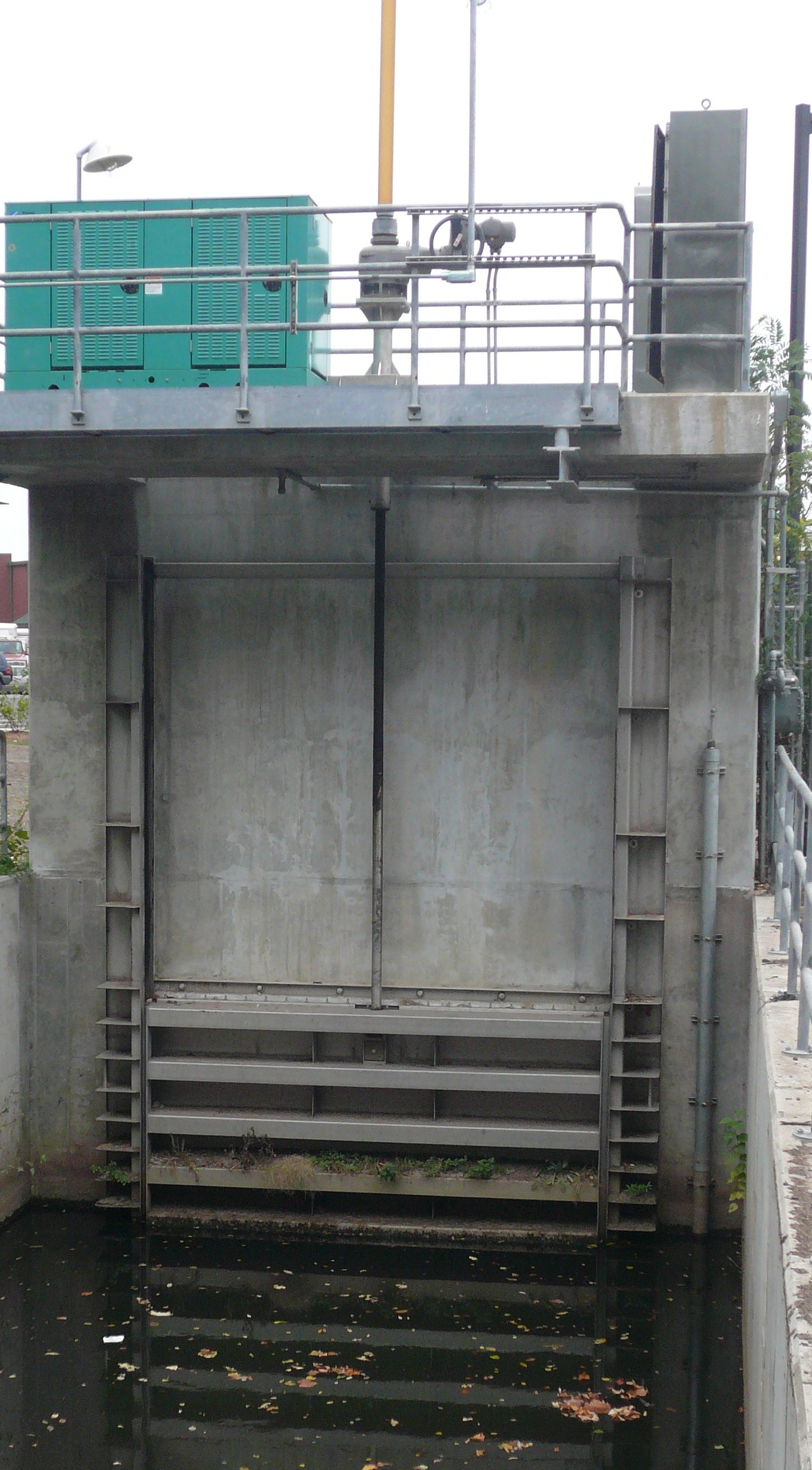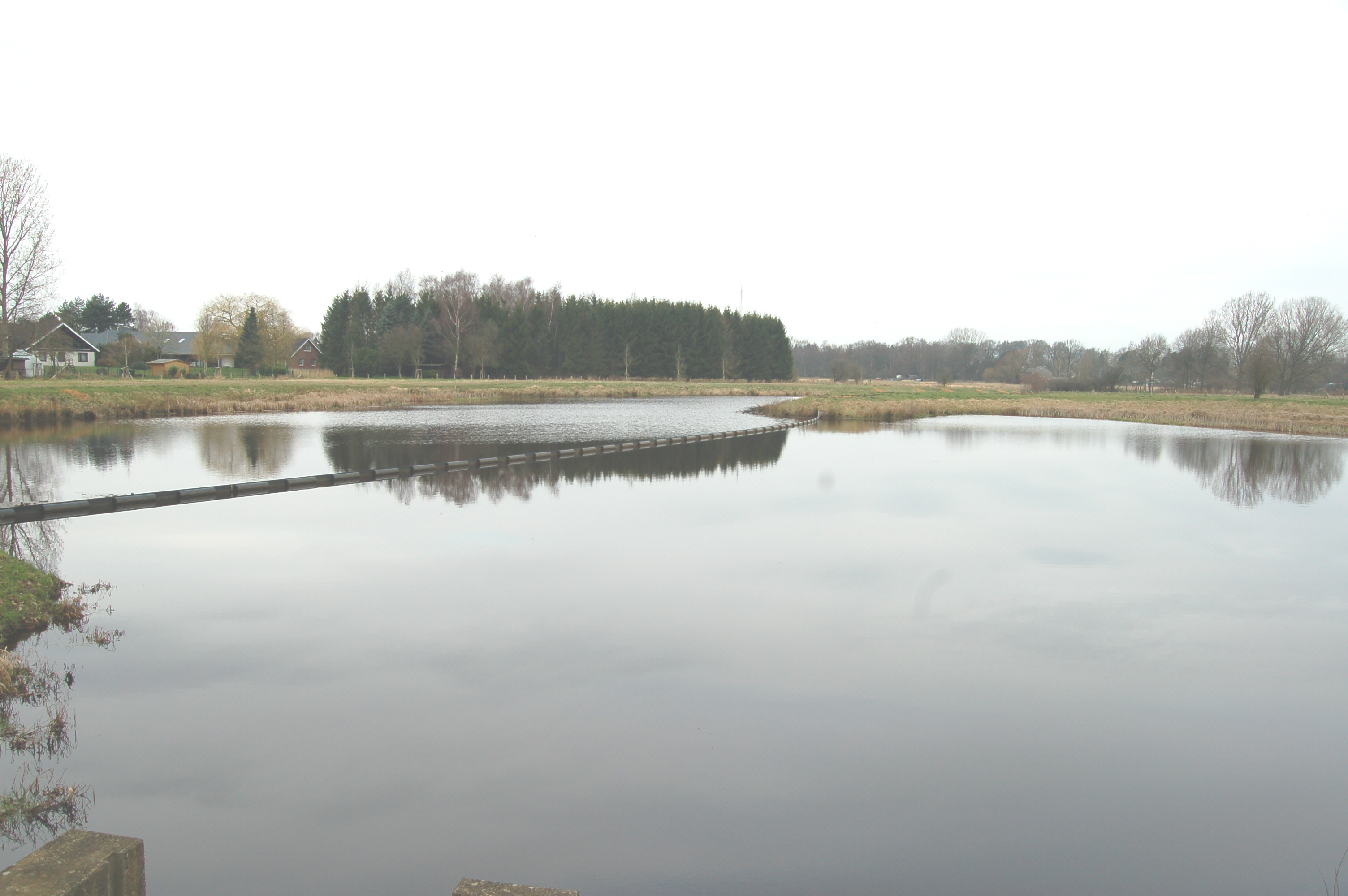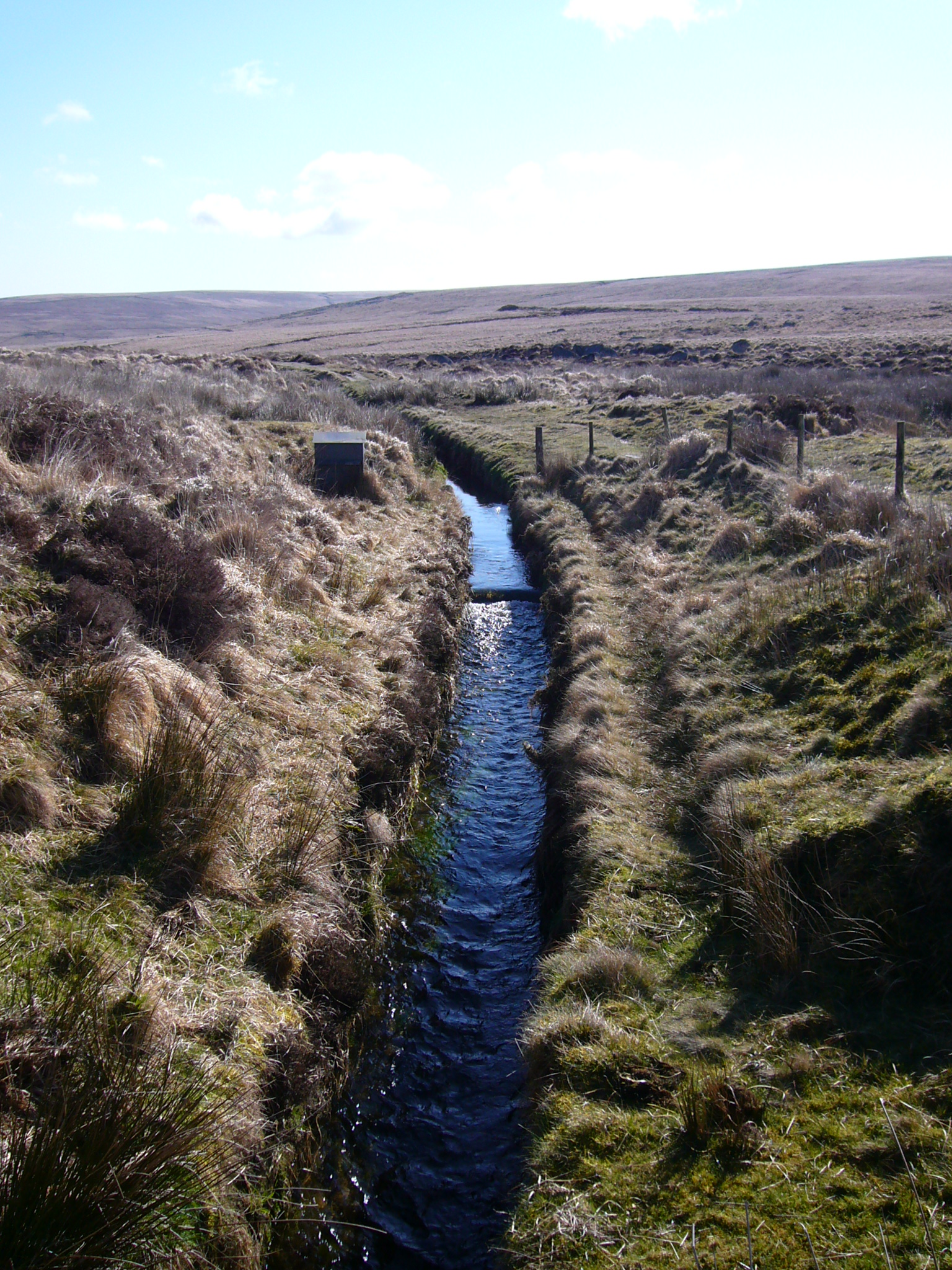|
Penstock
A penstock is a sluice or gate or intake structure that controls water flow, or an enclosed pipe that delivers water to hydro turbines and sewerage systems. The term is of Scots origin, and was inherited from the earlier technology of mill ponds and watermills, with penstocks diverting pond waters to drive the mills. Hydroelectric systems and dams Penstocks for hydroelectric installations are normally equipped with a gate system and a surge tank. They can be a combination of many components such as anchor block, drain valve, air bleed valve, and support piers depending on the application. Flow is regulated to suit turbine operation and is cut off when turbines are not in service. Penstocks, particularly where used in polluted water systems, need to be maintained by hot water washing, manual cleaning, antifouling coatings, allowing waters to go anoxic, and desiccation used to dry fouling out so that it may slough off or become easier to remove through manual processes. The t ... [...More Info...] [...Related Items...] OR: [Wikipedia] [Google] [Baidu] |
Watermill
A watermill or water mill is a mill that uses hydropower. It is a structure that uses a water wheel or water turbine to drive a mechanical process such as mill (grinding), milling (grinding), rolling, or hammering. Such processes are needed in the production of many material goods, including flour, lumber, paper, textiles, and many metal products. These watermills may comprise gristmills, sawmills, paper mills, textile mills, hammermills, trip hammering mills, rolling mills, and wire drawing mills. One major way to classify watermills is by wheel orientation (vertical or horizontal), one powered by a vertical waterwheel through a Gear train, gear mechanism, and the other equipped with a horizontal waterwheel without such a mechanism. The former type can be further subdivided, depending on where the water hits the wheel paddles, into undershot, overshot, breastshot and pitchback (backshot or reverse shot) waterwheel mills. Another way to classify water mills is by an essential tr ... [...More Info...] [...Related Items...] OR: [Wikipedia] [Google] [Baidu] |
Hydroelectric Power Stations
Hydroelectricity, or hydroelectric power, is Electricity generation, electricity generated from hydropower (water power). Hydropower supplies 15% of the world's electricity, almost 4,210 TWh in 2023, which is more than all other Renewable energy, renewable sources combined and also more than nuclear power. Hydropower can provide large amounts of Low-carbon power, low-carbon electricity on demand, making it a key element for creating secure and clean electricity supply systems. A hydroelectric power station that has a dam and reservoir is a flexible source, since the amount of electricity produced can be increased or decreased in seconds or minutes in response to varying electricity demand. Once a hydroelectric complex is constructed, it produces no direct waste, and almost always emits considerably less greenhouse gas than fossil fuel-powered energy plants. [...More Info...] [...Related Items...] OR: [Wikipedia] [Google] [Baidu] |
Sluice
A sluice ( ) is a water channel containing a sluice gate, a type of lock to manage the water flow and water level. There are various types of sluice gates, including flap sluice gates and fan gates. Different depths are calculated when design sluice gates. Sluices are used for channeling water toward a water mill, including for transporting logs from steep hillsides. Different terms are used regionally for sluices; the terms ''sluice'', ''sluice gate'', ''knife gate'', and ''slide gate'' are used interchangeably in the water and wastewater control industry. Etymology The term "sluice" originates from the Middle English word scluse, which derived from the Old French escluse (modern French: écluse). This, in turn, came from the Late Latin exclusa, a shortening of aqua exclusa, meaning "excluded water" or "a shut-off water channel." The Latin exclusa is the feminine past participle of excludere ("to shut out, exclude"), from *ex-* ("out") and claudere ("to close"). Regional ... [...More Info...] [...Related Items...] OR: [Wikipedia] [Google] [Baidu] |
JICA
The Japan International Cooperation Agency (), also known as JICA'','' is a governmental agency that delivers the bulk of Official Development Assistance (ODA) for the government of Japan. It is chartered with assisting economic and social growth in developing countries and promoting international cooperation. According to the OECD, Japan's total official development assistance (ODA) (US$17.5 billion, grant-equivalent methodology, preliminary data) increased in 2022 due to an increase in its bilateral lending, which included support to Ukraine. ODA represented 0.39% of gross national income (GNI). The OECD's Development Assistance Committee published a peer review of Japan's development cooperation in October 2020. JICA was led by Shinichi Kitaoka, the former President of the International University of Japan, from 2015 to 2022. On 1 April 2022, Professor Akihiko Tanaka assumed the presidency. History JICA was formed in 2003 as a result of a comprehensive overhaul of Japan's ... [...More Info...] [...Related Items...] OR: [Wikipedia] [Google] [Baidu] |
Aqueducts
Aqueduct may refer to: Structures *Aqueduct (bridge), a bridge to convey water over an obstacle, such as a ravine or valley *Navigable aqueduct, or water bridge, a structure to carry navigable waterway canals over other rivers, valleys, railways or roads *Aqueduct (water supply), a watercourse constructed to convey water **Acequia, a community-operated watercourse used in Spain and former Spanish colonies in the Americas ** Aryk, an artificial channel for redirecting water in Central Asia and other countries ** Elan aqueduct carries water to Birmingham **Levada, an irrigation channel or aqueduct specific to the Portuguese island of Madeira ** Puquios, underground water systems in Chile and Peru *Roman aqueduct, water supply systems constructed during the Roman Empire **Aqueduct of Segovia, a Roman aqueduct in Segovia, Spain Anatomy *Cerebral aqueduct in the brain *Vestibular aqueduct in the inner ear Places *Aqueduct, former name of Monolith, California, U.S. *Aqueduct, New Y ... [...More Info...] [...Related Items...] OR: [Wikipedia] [Google] [Baidu] |
Retention Basin
A retention basin, sometimes called a retention pond, wet detention basin, or storm water management pond (SWMP), is an artificial pond with vegetation around the perimeter and a permanent pool of water in its design. It is used to manage stormwater runoff, for protection against flooding, for erosion control, and to serve as an artificial wetland and improve the water quality in adjacent bodies of water. It is distinguished from a detention basin, sometimes called a "dry pond", which temporarily stores water after a storm, but eventually empties out at a controlled rate to a downstream water body. It also differs from an infiltration basin which is designed to direct stormwater to groundwater through permeable soils. Wet ponds are frequently used for water quality improvement, groundwater recharge, flood protection, aesthetic improvement, or any combination of these. Sometimes they act as a replacement for the natural absorption of a forest or other natural process ... [...More Info...] [...Related Items...] OR: [Wikipedia] [Google] [Baidu] |
Flume
A flume is a human-made channel for water, in the form of an open declined gravity chute whose walls are raised above the surrounding terrain, in contrast to a trench or ditch. Flumes are not to be confused with aqueducts, which are built to transport water; flumes use flowing water to transport materials. Flumes route water from a diversion dam or weir to a desired materiel collection location. Flumes are usually made up of wood, metal or concrete. Many flumes took the form of wooden troughs elevated on trestles, often following the natural contours of the land. Originating as a part of a mill race, they were later used in the transportation of logs in the logging industry, known as a log flume. They were also extensively used in hydraulic mining and working placer deposits for gold, tin and other heavy minerals. Etymology The term ''flume'' comes from the Old French word ''flum'', from the Latin ''flumen'', meaning a river. It was formerly used for a stream, and particul ... [...More Info...] [...Related Items...] OR: [Wikipedia] [Google] [Baidu] |
Leat
A leat (; also lete or leet, or millstream) is the name, common in the south and west of England and in Wales, for an artificial watercourse or aqueduct dug into the ground, especially one supplying water to a watermill or its mill pond. Other common uses for leats include delivery of water for hydraulic mining and mineral concentration, for irrigation, to serve a dye works or other industrial plant, and provision of drinking water to a farm or household or as a catchment cut-off to improve the yield of a reservoir. According to the ''Oxford English Dictionary'', ''leat'' is cognate with ''let'' in the sense of "allow to pass through". Other names for the same thing include ''fleam'' (probably a leat supplying water to a mill that did not have a millpool). In parts of northern England, for example around Sheffield, the equivalent word is ''goit''. In southern England, a leat used to supply water for water-meadow irrigation is often called a ''carrier'', ''top carrier'', or ... [...More Info...] [...Related Items...] OR: [Wikipedia] [Google] [Baidu] |
Shelsley Walsh Watermill - Penstock (geograph 3368545)
The Shelsleys are a group of small villages in the Malvern Hills District in the county of Worcestershire, England. Situated on either wide of the Teme Valley near the village of Clifton-upon-Teme, they encompass the formerly distinct civil parishes of Shelsley Beauchamp, Shelsley Kings and Shelsley Walsh. The three merged in 1972 and now share a single parish council. History Shelsley means " clearing on a slope" from Old English scelf " shelf (of land)" and leāh "wood, clearing". The name was recorded as ''Scillislege'' in 948. Charles Nott, the Parson of Shelsley, was a leader of the Clubmen who in 1645 drew up the Woodbury Declaration, which listed the grievances that local people had at the behaviour of Royalist forces in the area. Following the Poor Law Amendment Act 1834 the Shelsleys Parish ceased to be responsible for maintaining the poor in its parish. This responsibility was transferred to Martley Poor Law Union. Shelsley Beauchamp Shelsley Beauchamp i ... [...More Info...] [...Related Items...] OR: [Wikipedia] [Google] [Baidu] |





